#solar disk
Text
2024 April 2
The Sun is shown during a total solar eclipse. Accentuated is the expansive corona of the Sun, which is shown streaming out in all directions.

Detailed View of a Solar Eclipse Corona
Image Credit & Copyright: Phil Hart
Explanation: Only in the fleeting darkness of a total solar eclipse is the light of the solar corona easily visible. Normally overwhelmed by the bright solar disk, the expansive corona, the sun's outer atmosphere, is an alluring sight. But the subtle details and extreme ranges in the corona's brightness, although discernible to the eye, are notoriously difficult to photograph. Pictured here, however, using multiple images and digital processing, is a detailed image of the Sun's corona taken during the April 20, 2023 total solar eclipse from Exmouth, Australia. Clearly visible are intricate layers and glowing caustics of an ever changing mixture of hot gas and magnetic fields. Bright looping prominences appear pink just around the Sun's limb. A similar solar corona might be visible through clear skies in a narrow swath across the North America during the total solar eclipse that occurs just six days from today
#astronaut#astronomers#not astrology#star#stars#art#astronomy#outer space#space#artist#ecplise#solar eclipse#sun#atmosphere#magnetic fields#april 20#exmouth#australia#north america#sun blocked by moon#solar ecplise corona#solar disk
26 notes
·
View notes
Note
please please please PLEASE share more on your Thoughts about gas giants!! i'd love to learn in a way that doesnt leave me baffled and half my brain leaking from my ears! you explained things so well in the psyche post and also i think things are generally more fun to learn from someone who is Excited To Share than from Published Research Papers where everything has been dried out For Professional Reasons- understandably so, mind, but i am not In The Field and dont know the terms lol
Okay it's taken me forever to get back to this but I AM SO GLAD YOU ASKED.
Like other planets, it all starts with a disk made of gas and dust orbiting an infant star, called a protoplanetary disk. Like these in the Orion Nebula, discovered by the Hubble!

To form terrestrial planets (rocky planets with relatively thin atmospheres like Mercury, Venus, Earth, and Mars), the gas in the protoplanetary disk coalesces to form hundreds and hundreds of rocky bodies called planetesimals, about a kilometer across. These planetesimals collide, and form dozens of protoplanets about the size of the moon. The protoplanets then collide as well, and stabilize to form the solar system as we know it today.
But, in the case of gas giants, colliding protoplanets don't form fully-finished planets. Instead, they form a core, or a seed.
We think the only thing that determines whether a planet will be terrestrial or a gas giant is simply how far away from the sun it forms - that's it. As a new sun warms its evolving solar system, it heats up the material in the protoplanetary disk. Close to the sun, the disk gets hotter, and things like water and other ices melt and evaporate into gas, making them difficult for the protoplanets to gravitationally capture. However, further away, the icy compounds stay cold enough to remain solid and coalesce along with rocky particles.
That boundary in the solar system - where ices evaporate to gas on the sunward side, and remain solid on the other - is called the "Frost Line". In our solar system, the Frost Line is right between Mars and Jupiter.

The protoplanets that form past the Frost Line turn into gas giant seeds, and are able to (kinda literally) snowball, picking up both rocky and icy material. With all that solid ice available, they grow far larger and far faster than planets in the inner solar system, and their gravity gets stronger and stronger. More gravity causes them to collect even MORE material until they're heavy enough to capture extremely lightweight elements like hydrogen and helium. Which, of course, makes them get even bigger and even heavier! Runaway growth!
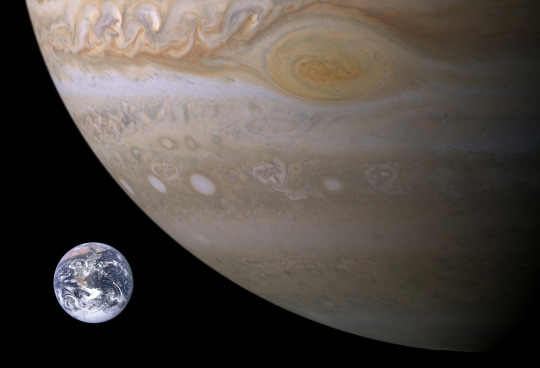
But weirdly, as we study more exoplanets (planets that orbit stars other than our sun), we keep finding these huge gas giants incredibly close to their stars! Like, even closer than Mercury is to ours, which is insane. These "Hot Jupiters" break so many rules - gas giants "should" only be able to form where ice stays frozen, but here they are up close and personal with their stars, like this artist's concept!

It's possible that these planets are in the process of migrating closer to their stars, and we're managing to see them before they evaporate, but we just! Keep! Finding them!
One of my favorite parts of planetary science is how much we still have to learn. We'll think we have a pretty good idea of how things work out there, and then suddenly we'll find something that we can't explain. And there's an entire universe of weird shit - we've barely begun to scratch the surface!
#space#planets#jupiter#gas giants#astrophysics#planetary formation#Hubble#spost#asked and answered#anxiousdemifaemess#it's crazy though#in the early solar system about 98% of the material in the protoplanetary disk is hydrogen and helium#which is so lightweight it's entirely unavailable for planetary formation#it never coalesces and eventually just blows away#or gets eaten by the star#gas giants are able to utilize even a tiny fraction of that material#which is why they get so big!#The Frost Line is the reaso all our gas giants are far away and why we don't see rocky planets like mars hanging out past Jupiter and Satur#Or rather it would be#IF HOT JUPITERS WEREN'T EVERYWHERE RUINING THAT THEORY
143 notes
·
View notes
Text
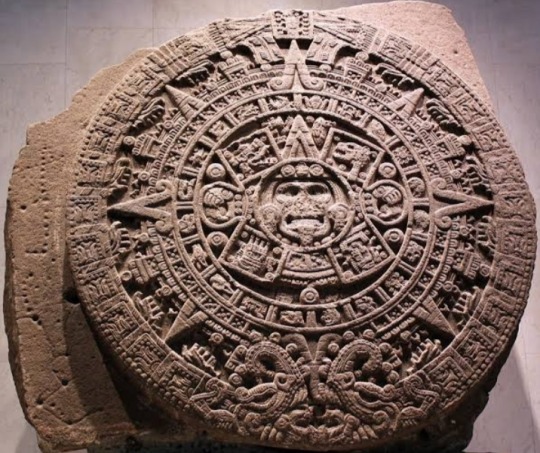
Aztec Sun Stone (Calendar Stone) depicts five consecutive worlds of the sun from Aztec mythology.
Stone is not, therefore, in any sense a functioning calendar, but rather it is an elaborately carved solar disk, which for Aztecs and other Mesoamerican cultures represented rulership.
At the top of the stone is a date glyph (13 reed), which represents both beginning of the present sun, fifth and final one according to mythology, and the actual date 1427 CE, thereby legitimizing the rule of Itzcoatl (who took power in that year) and creating a bond between divine and mankind.
Stone was discovered in December 1790 CE in central plaza of Mexico City. It now resides in National Museum of Anthropology in that city.
The richly carved basalt stone was once a part of the architectural complex of Temple Mayor and measures 3.58m in diameter, is 98cm thick, and weighs 25 tons.
Stone would originally have been laid flat on the ground and possibly anointed with blood sacrifices.
When it was discovered, the stone was lying flat and upside down, perhaps in an attempt to prevent the final cataclysm — fall of fifth and final sun as Aztec world fell apart following the attack from Old World.
At the centre of the stone is a representation of either the sun god Tonatiuh (the Day Sun) or Yohualtonatiuh (the Night Sun) or the primordial earth monster Tlaltecuhtli, in the latter case representing the final destruction of the world when the fifth sun fell to earth.
The tongue is perhaps also a sacrificial knife and, sticking out, it suggests a thirst for blood and sacrifice.
Around the central face at four points are other four suns, which successively replaced each other after gods Quetzalcoatl and Tezcatlipoca struggled for control of the cosmos until the era of the fifth sun was reached.
The suns are known by the day name on which their final destruction occurred.
Beginning from the top right, there is the first sun Nahui Ocelotl (4 - Jaguar), top left is the second sun Nahui Ehécatl (4 - Wind), bottom left the third sun Nahui Quiáhuitl (4 - Rain), and bottom right is the fourth sun Nahui Atl (4 - Water).
On either side of the central face are two jaguar heads or paws, each clutching a heart, representing the terrestrial realm.
The band running immediately around the suns is segmented into the 20 Aztec day-names (hence Calendar Stone name).
Then there is a decorative ring surrounded by another ring depicting symbols, which represent turquoise and jade, symbols of the equinoxes and solstices, and the colours of the heavens.
Two heads at bottom centre represent fire serpents, and their bodies run around perimeter of the stone with each ending in a tail.
Four cardinal and the inter-cardinal directions are also indicated with larger and lesser points respectively.
#Aztec Sun Stone#Calendar Stone#Aztec mythology#carved solar disk#date glyph#National Museum of Anthropology
33 notes
·
View notes
Text

My interpretation of the Solar Eclipse. The next one will be August 12, 2026, this is a reason to go to Spain.
Glory to the great and wonderful Lord Ra!
#Gods of Egypt#ancient Egyptian religion#egyptian gods#Sun disk#shadow theater#shadow play#Ra#Ра#боги египта#Ancient Egypt#vector art#vector illustration#Solar Eclipse#the sun#Eclipse#God Ra#Lord Ra
14 notes
·
View notes
Text
WHY DIDN'T KRILLIN USE A KIENZAN AFTER THE SOLAR FLARE AGAINST FREEZA?
The Destructo Disk us a technique that takes up a lot of ki. Krillin threw FIVE Destructo Disks at Freeza.


Krillin used up even more ki to lead Freeza away from Gohan so that Dende could heal him. You can see him sweating from giving it his all.

Then, Krillin used used the Solar Flare to blind Freeza & make him vulnerable for attack. But, he didn't have enough ki to make another Kienzan to kill Freeza. Dude was exhausted, which is why Krillin asked Vegeta to attack Freeza instead.

If Vegeta was paying attention, he could have used some attack on Freeza & possibly defeated him.
Where's that What-If story? "What-If Vegeta Listened To Krillin?"
#Krillin#Kuririn#Kienzan#Destructo Disk#Freeza#Frieza#DB#DBZ#DBS#what if Vegeta listened to Krillin?#I'm sure ppl already realize this#but I often see folks complaining about Krillin not using a Kienza after his Solar Flare#or someone will make a video criticizing Krillin for not doing this#context is key
16 notes
·
View notes
Text
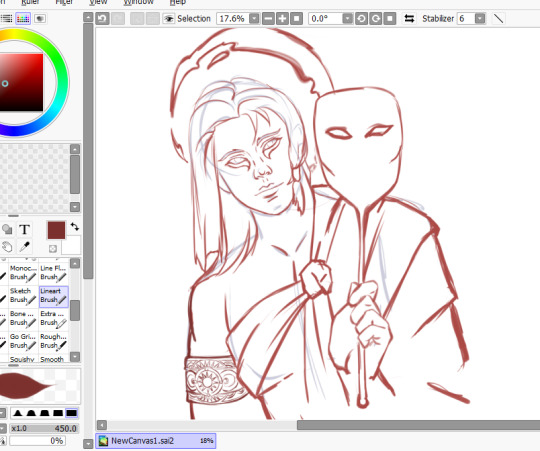

A sketch for my second Shadow Theater blog.
My interpretation of the Solar Eclipse. The next one will be August 12, 2026, this is a reason to go to Spain.
Glory to the great and wonderful Lord Ra!
#galgannet#Gods of Egypt#ancient Egyptian religion#egyptian gods#Sun disk#Ra#Ра#боги египта#Ancient Egypt#Solar Eclipse#the sun#Eclipse#God Ra#Lord Ra#sketch#kemetism
7 notes
·
View notes
Text

Happy eat the sun day
#solar eclipse#total eclipse#eclipse 2024#my art#art#btw we bought an obsidian disk in Mexico to view the eclipse through#it was so cool
7 notes
·
View notes
Text
Survey of More Than 800 Planet-Forming Disks Reveals a Planetary Evolution Surprise
Survey of More Than 800 Planet-Forming Disks Reveals a Planetary Evolution Surprise
Is our Solar System comparable to other solar systems? What do other systems look like? We know from exoplanet studies that many other systems have hot Jupiters, massive gas giants that orbit extremely close to their stars. Is that normal, and our Solar System is the outlier?
One way of addressing these questions is to study the planet-forming disks around young stars to see how they evolve.
But…
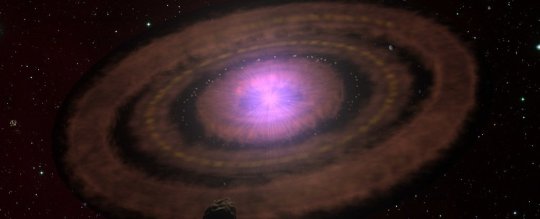
View On WordPress
4 notes
·
View notes
Link
The Space, Astronomy & Science Podcast.
SpaceTime Series 27 Episode 38
*Witnessing the Final Stages of Planetary Formation
For the first time, astronomers have captured the end of the planetary formation process, observing the dispersal of gas from a young star's circumstellar disk. The James Webb Space Telescope has provided unprecedented images of the Tchar star system, where a vast gap in its disk suggests we're witnessing the final act in its planetary evolution. The study sheds light on the fate of gas giants and terrestrial planets, revealing the delicate dance of creation that shapes nascent solar systems.
*The Devil's Comet: A Green Spectacle in the Sky
Comet 12P/Pons-Brooks, with its distinctive green hue and horned appearance, is making its first visit to the inner solar system in over 70 years. This Mount Everest-sized icy wanderer could grace our skies with its naked-eye visibility as it reaches perihelion this April. Nicknamed the 'Devil's Comet', its cryovolcanic nature promises a celestial show that won't return until 2095.
*The Dust that Doomed Dinosaurs
A new study proposes that fine dust particles from the Chicxulub asteroid impact contributed significantly to the mass extinction event that ended the reign of the non-avian dinosaurs. By blocking photosynthesis and plunging the Earth into a cold, dark winter, this fine dust may have been the final nail in the coffin for many species, reshaping life on our planet forever.
For more SpaceTime and to support the show, visit our website at https://spacetimewithstuartgary.com where you can access our universal listen link, find show notes, and learn how to become a patron.
Listen to SpaceTime on your favorite podcast app with our universal listen link: https://spacetimewithstuartgary.com/listen and access show links via https://linktr.ee/biteszHQ
Support the show: https://www.spreaker.com/podcast/spacetime-with-stuart-gary--2458531/support
For more space and astronomy podcasts, visit our HQ at https://bitesz.com
#12p/pons-brooks#circumstellar#comet#disk#formation#gas#gases#giants#ionization#james#noble#perihelion#planetary#protoplanetary#solar#space#system#telescope#visibility#webb
0 notes
Text
Black Hole Friday Deals!
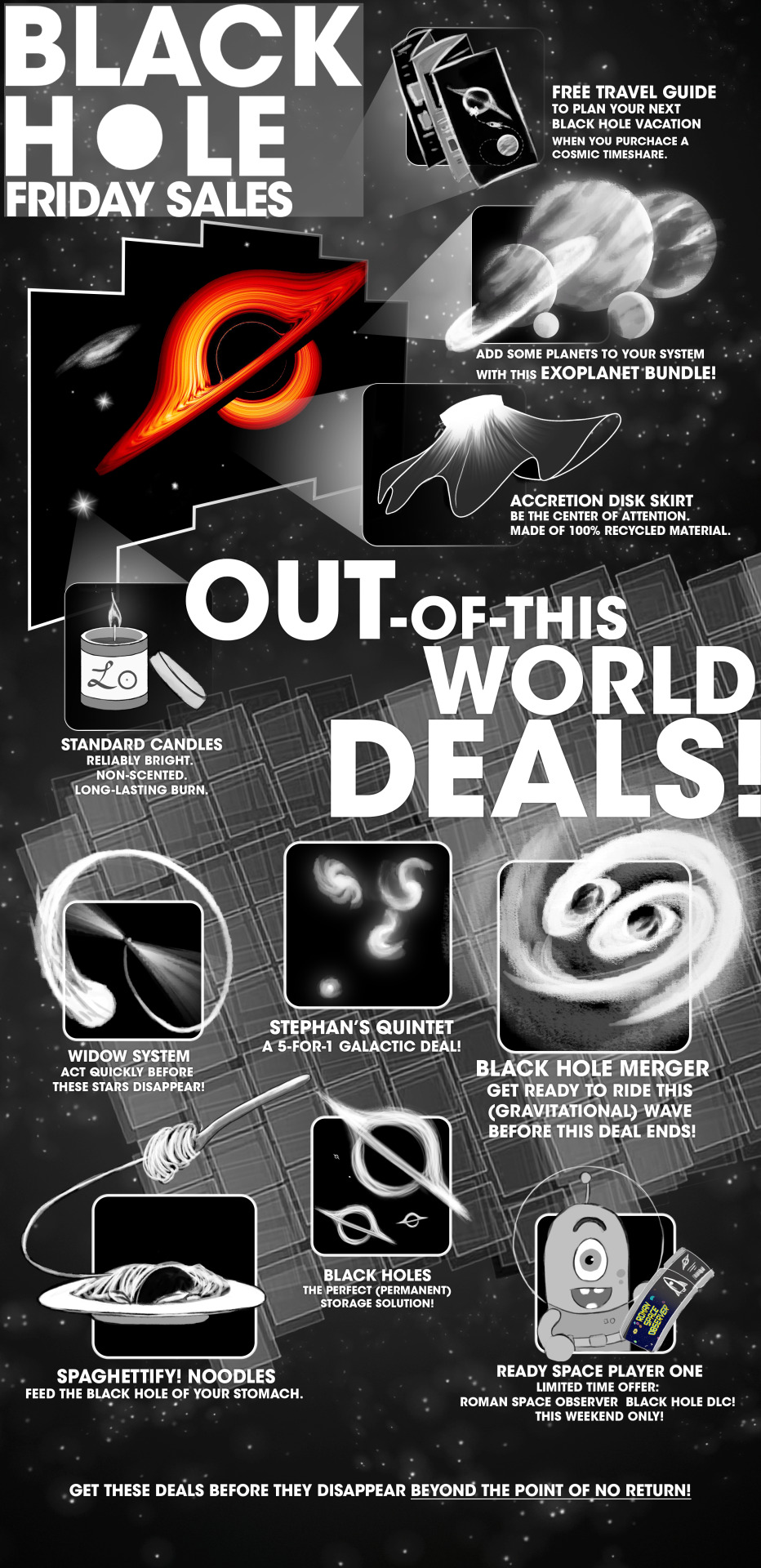
Get these deals before they are sucked into a black hole and gone forever! This “Black Hole Friday,” we have some cosmic savings that are sure to be out of this world.
Your classic black holes — the ultimate storage solution.
Galactic 5-for-1 special! Learn more about Stephan’s Quintet.
Limited-time offer game DLC! Try your hand at the Roman Space Observer Video Game, Black Hole edition, available this weekend only.
Standard candles: Exploding stars that are reliably bright. Multi-functional — can be used to measure distances in space!
Feed the black hole in your stomach. Spaghettification’s on the menu.
Act quickly before the stars in this widow system are gone!
Add some planets to your solar system! Grab our Exoplanet Bundle.
Get ready to ride this (gravitational) wave before this Black Hole Merger ends!
Be the center of attention in this stylish accretion disk skirt. Made of 100% recycled cosmic material.
Should you ever travel to a black hole? No. But if you do, here’s a free guide to make your trip as safe* as possible. *Note: black holes are never safe.
Make sure to follow us on Tumblr for your regular dose of space!
#NASA#astronomy#telescope#Roman Space Telescope#black holes#galaxies#cosmology#astrophysics#stars#galaxy#Hubble#Webb#space#exoplanets#science#physics#comic#comics#comic art
3K notes
·
View notes
Text
Survey of More Than 800 Planet-Forming Disks Reveals a Planetary Evolution Surprise
Survey of More Than 800 Planet-Forming Disks Reveals a Planetary Evolution Surprise
Is our Solar System comparable to other solar systems? What do other systems look like? We know from exoplanet studies that many other systems have hot Jupiters, massive gas giants that orbit extremely close to their stars. Is that normal, and our Solar System is the outlier?
One way of addressing these questions is to study the planet-forming disks around young stars to see how they…

View On WordPress
0 notes
Photo

2024 April 2
Detailed View of a Solar Eclipse Corona
Image Credit & Copyright: Phil Hart
Explanation: Only in the fleeting darkness of a total solar eclipse is the light of the solar corona easily visible. Normally overwhelmed by the bright solar disk, the expansive corona, the sun's outer atmosphere, is an alluring sight. But the subtle details and extreme ranges in the corona's brightness, although discernible to the eye, are notoriously difficult to photograph. Pictured here, however, using multiple images and digital processing, is a detailed image of the Sun's corona taken during the April 20, 2023 total solar eclipse from Exmouth, Australia. Clearly visible are intricate layers and glowing caustics of an ever changing mixture of hot gas and magnetic fields. Bright looping prominences appear pink just around the Sun's limb. A similar solar corona might be visible through clear skies in a narrow swath across the North America during the total solar eclipse that occurs just six days from today
∞ Source: apod.nasa.gov/apod/ap240402.html
256 notes
·
View notes
Text
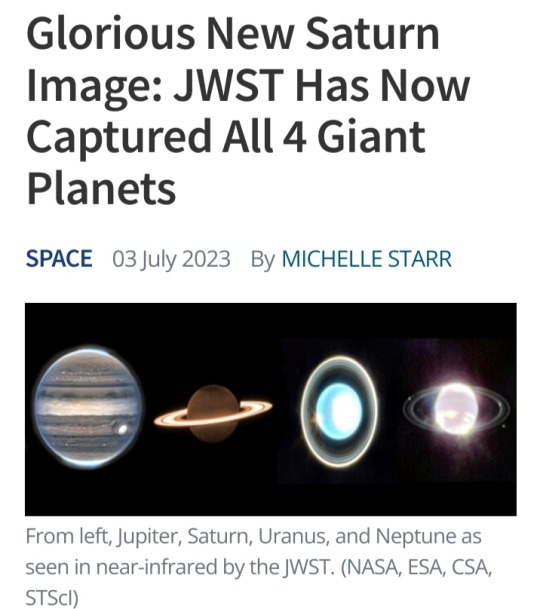
With the addition of Saturn, the James Webb Space Telescope has finally captured all four of our Solar System's giant worlds.
JWST's observations of the ringed planet, taken on 25 June 2023, have been cleaned up and processed, giving us a spectacular view of Saturn's glorious rings, shining golden in the darkness.
By contrast, the disk of Saturn is quite dark in the new image, lacking its characteristic bands of cloud, appearing a relatively featureless dim brown.
This is because of the wavelengths in which JWST sees the Universe – near- and mid-infrared.
These wavelengths of light are usually invisible to the naked human eye, but they can reveal a lot.
For example, thermal emission – associated with heat – is dominated by infrared wavelengths.
When you're trying to learn about what's going on inside a planet wrapped in thick, opaque clouds, studying its temperature is a valuable way to go about it.
Some elements and chemical processes emit infrared light, too. Seeing the planets of the Solar System in wavelengths outside the narrow range admitted by our vision can tell us a lot more about what they have going on.
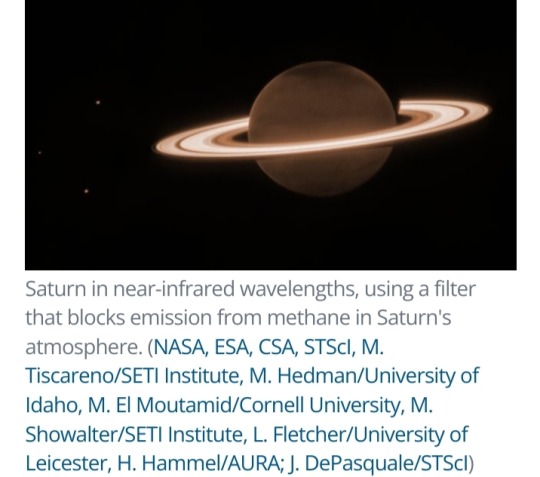
Saturn
As we saw last week, when we clapped eyes on the raw JWST Saturn images, the observations involved filters that dimmed the light of the planet, while allowing light from the rings and moons to shine brightly.
This is so a team led by planetary scientist Leigh Fletcher of the University of Leicester in the UK can study the rings and moons of Saturn in more detail.
They hope to identify new ring structures and, potentially, even new moons orbiting the gas giant.
The image above shows three of Saturn's moons, Dione, Enceladus and Tethys, to the left of the planet.
Although dim, the disk of the planet also reveals information about Saturn's seasonal changes.
The northern hemisphere is reaching the end of its 7-year summer, but the polar region is dark. An unknown aerosol process could be responsible.
Meanwhile, the atmosphere around the edges of the disk appears bright, which could be the result of methane fluorescence, or the glow of trihydrogen, or both. Further analysis could tell us which.

Jupiter
Jupiter was the first of the giant planets to get the JWST treatment, with images dropping in August of last year – and boy howdy were they stunning.
The spectacular detail seen in the planet's turbulent clouds and storms was perhaps not entirely surprising.
However, we also got treated to some rarely seen features: the permanent aurorae that shimmer at Jupiter's poles, invisible in optical wavelengths, and Jupiter's tenuous rings.
We also saw two of the planet's smaller, lesser-known moons, Amalthea and Adrastea, with fuzzy blobs of distant galaxies in the background.
"This one image sums up the science of our Jupiter system program, which studies the dynamics and chemistry of Jupiter itself, its rings, and its satellite system," said astronomer Thierry Fouchet of Paris Observatory in France, who co-led the observations.
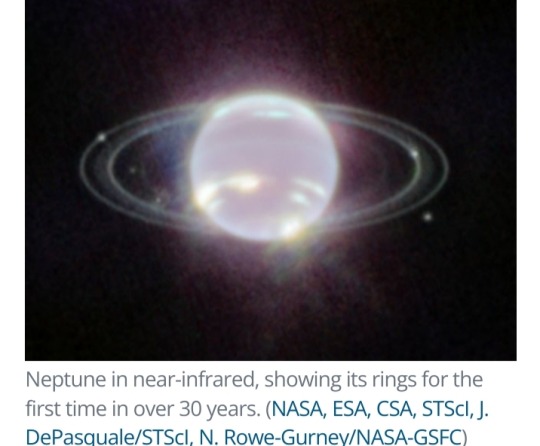
Neptune
Observations of Neptune arrived in the latter half of September 2022.
Because Neptune is so very far away, it tends to get a little neglected; you're probably used to seeing, if anything, the images taken by Voyager 2 when it flew past in 1989.
JWST's observations gave us, for the first time in more than 30 years, a new look at the ice giant's dainty rings – and the first ever in infrared.
It also revealed seven of Neptune's 14 known moons, and bright spots in its atmosphere.
Most of those are storm activity, but if you look closely, you'll see a bright band circling the planet's equator.
This had never been seen before and could be, scientists say, a signature of Neptune's global atmospheric circulation.
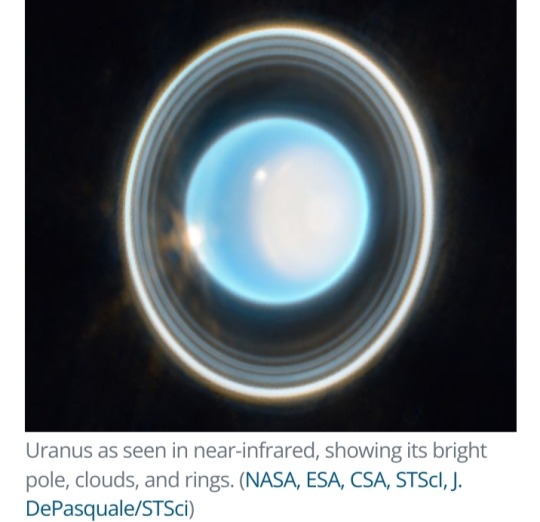
Uranus
Uranus is also pretty far away, but it's also a huge weirdo. Although very similar to Neptune, the two planets are slightly different hues, which is something of a mystery.
Uranus is also tipped sideways, which is challenging to explain too.
JWST's observations, released in April 2023, aren't solving these conundrums.
However, they have revealed 11 of the 13 structures of the incredible Uranian ring system and an unexplained atmospheric brightening over the planet's polar cap.
JWST has a lot to say about the early Universe; but it's opening up space science close to home, too.
As its first year of operations comes to an end, we can't help but speculate what new wonders will be to come in the years ahead.

Top: Jupiter - Neptune / Bottom: Uranus - Saturn
Credit: NASA
#James Webb Space Telescope#Solar System#Saturn#Jupiter#Uranus#Neptune#planets#space#universe#infrared wavelengths#wavelengths#JWST#Leigh Fletcher#planetary science#Thierry Fouchet#moons#Voyager 2#giant planets#astronomy
1K notes
·
View notes
Text
It’s impossible to capture or describe what totality feels like. It becomes viscerally clear why some ancient civilizations feared eclipses, saw them as anger from the gods. Even well knowing the science behind it, TEACHING it, you get overtaken by the Wrongness of it all. The minutes before and after totality, when the sun still shines but the light hitting the ground dims drastically all around you; the air changes, the temperature lowers, a cool breeze kicks up; the geese start to squawk and fly, the crickets start their chirping. And when the sky has reached a haunting midday sunset all around you, you see the sun, this thing that is so reliable and predictable and constant, this thing that gives us life, disappear and transform into a pitch black disk before your eyes. The absence of its light and the bright spray of the corona behind the moon looks like someone tacked an odd lamp on a wall. It doesn’t make sense, it doesn’t look like it can be real. I’ve seen it twice now and it still seems so impossible.
I can’t believe how different this one felt from 2017. The bigger shadow allowed nearly two more minutes of totality, and I felt every second of those four minutes. It was a noticeable full sensory experience - I felt the cooling air so much more, we sat in the dim pre-totality twilight for so much longer, the geese and the crickets warned us early. When totality hit we got to relish in it. I’m glad I snapped a few hasty photos but mostly I just couldn’t tear my eyes away. I didn’t want to blink. The corona was sprawling, and those bright pink solar prominences took my breath away. There is nothing that compares to that sight. Nothing comes close. I’m so grateful to have gotten to see this. I’m so lucky.
But my favorite part by far is seeing so many people I love getting to see it too. I love sharing this. I want to see everyone’s pictures and videos!!!! We really saw this impossible thing!!!
#eclipse 2024#sorry if you follow me on other socials this is going everywhere LOLLLLLLL#anyway here’s one minute of me losing my shit
154 notes
·
View notes
Text
So I wanna tell y'all about something very near and dear to my heart.

This is the Psyche asteroid, or, at least an artist's representation - we don't know what it actually looks like yet, but this is a fair enough guess. It's a roughly 200 mile wide asteroid in the asteroid belt, and it's made almost entirely out of metal. Its composition makes it unique; it’s the only large metallic body we know of in the entire solar system.
We think it might be the core of what used to be a planet.
When solar systems form, they start out as disks made of interstellar gas and dust, called protoplanetary disks. Here's a picture of HL Tauri, one of the best images of a protoplanetary disk we have.
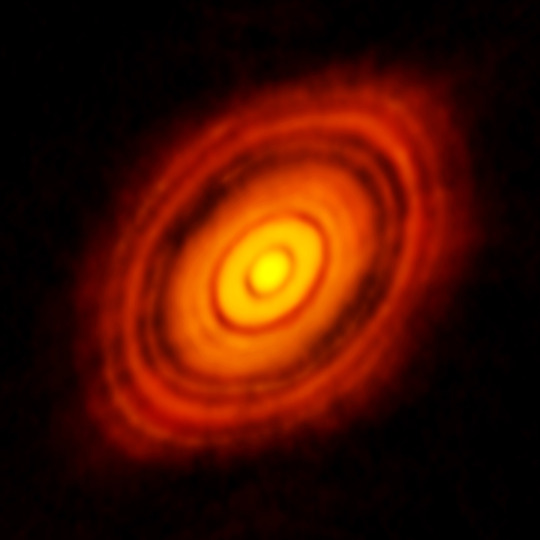
That dust globs together into larger and larger pieces, and eventually forms hundreds of "planetesimals", which are rocky bodies about a kilometer across. Planetesimals had very erratic orbits compared to the modern planets - the dust of the protoplanetary disk caused friction and drag, which threw them off course.
They frequently collided with each other, and either broke apart or stuck together and grew even larger. Arrokoth is actually a leftover planetesimal, a time capsule from the early solar system, and we were able to visit it wayyy out in the Kuiper belt with the New Horizons probe!
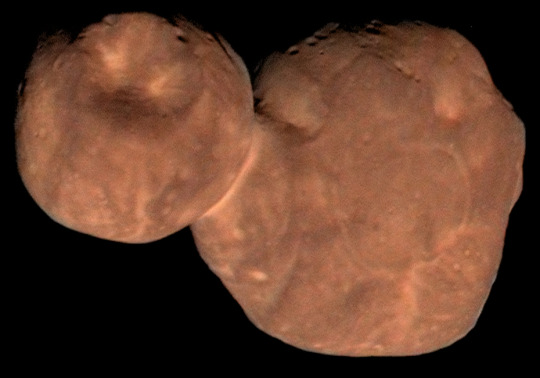
Once planetesimals get to be about the size of the moon, we call them "protoplanets". Protoplanets were fundamentally different from their planetesimal siblings - we believe they were differentiated. When an object in space gets big enough, a combination of radioactive decay, impacts, and gravitational pressure causes them to heat up and melt. Denser materials like iron and nickel sink towards their centers, while the lighter materials rise to the surface. The differentiation process is why Earth's core is made of iron, while the surface is primarily rock.
While protoplanet orbits were much more stable than those of planetesimals, they still eventually collided with each other until everything settled into the planets we see today (though gas giants had a few extra steps - that's a different post!).
We think the Psyche asteroid was a protoplanet, well on its way to becoming a bona fide planet, when an impact struck it hard enough to strip away its rocky layers, leaving behind the dense, metallic core - like in this illustration.
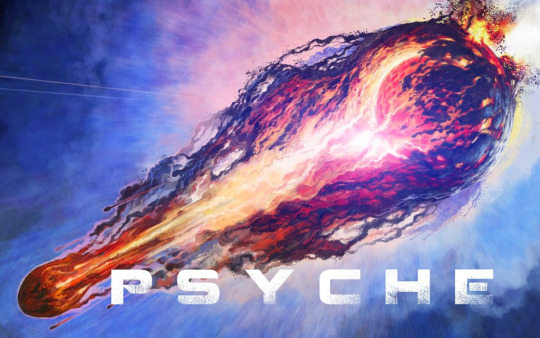
More and more, we think the properties of a planet's core are fundamental to its long-term evolution. Venus, Earth, and Mars are all roughly the same size and roughly the same distance from the sun, cosmically speaking, yet they're so different! Venus has hell death clouds, Earth is home, and Mars is dry and dead - why?
The Psyche asteroid gives us the unique opportunity to actually observe a planetary core directly - it's much harder to dig to the center of a planet than it is to go to space, so that's exactly what we're going to do!
On Thursday October 12th at 10:16am Eastern, the Psyche spacecraft will launch and begin its journey to the asteroid belt! You can watch at https://www.nasa.gov/nasatv/!

I've been a part of this mission for over four years now, and I can't speak highly enough of the team that made it happen through all of the ups and downs. Good luck out there, buddy. We're all rooting for you :')
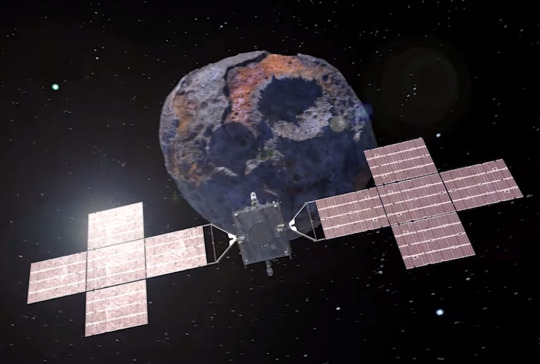
#space#NASA#psyche#asteroid#planet#psyche mission#long post#get home safe friend#you're gonna see some amazing things#For real y'all this mission has been my every single day for the past four years#I grew up with this project#end of an era but beginning of something new!#spost
377 notes
·
View notes
Text
someone said this should have been a poll and they were right, so
340 notes
·
View notes